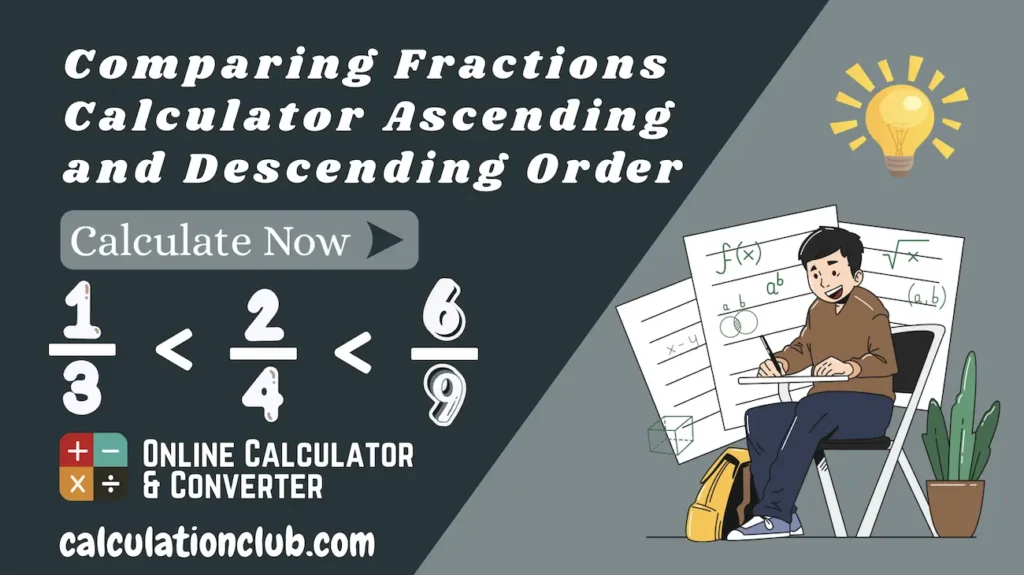Online Fraction Calculator
Fraction Calculator is an online tool that simplifies the process of performing arithmetic operations on fractions. Whether you’re adding, subtracting, multiplying, or dividing fractions, this tool delivers accurate results in seconds. It not only provides the final fraction result but also breaks down the calculations step by step for better understanding.
Most online fraction calculators only allow operations between two fractions, with only 10% supporting up to five fractions. However, CalculationClub.com offers a unique fraction calculator that lets you perform calculations with an unlimited number of fractions, making it a powerful and versatile tool for all your fraction needs.
With this tool, you can effortlessly compute operations between two or more fractions, such as $\frac{5}{14}$ + $\frac{2}{3}$ or $\frac{5}{7}$ ÷ $\frac{2}{3}$. Whether you’re a student solving math problems, a professional needing precise calculations, or someone looking to understand fractions better, this calculator is designed to be fast, user-friendly, and reliable.
How to Use the Online Fraction Calculator?
1. Adding a Fraction: Click the “Add Fraction” button to insert a new fraction input field. A new numerator and denominator box will appear, along with an operator (+, -, ×, ÷). You can add multiple fractions by repeating this step.
2. Removing a Fraction: Click the “Remove Fraction” button to delete the last added fraction along with its operator.
3. Entering Fractions: Adjust the input boxes by adding numerators and denominators as needed. You cannot enter decimal values—only whole numbers are allowed. The numerator and denominator fields cannot be left empty or set to zero.
4. Performing Calculations: After entering all fractions, click the “Calculate” button. The calculator will display the result along with detailed step-by-step calculations. The result will be shown as:
- A proper or improper fraction
- A mixed fraction (if applicable)
- A decimal equivalent
5. Hiding Calculation Steps: Click the “Hide Steps” button to conceal the detailed solution steps.
6. Resetting the Calculator: Click the “Reset” button to clear all input fields and restart the calculation process.
This tool ensures accurate fraction operations with a user-friendly interface, making it ideal for students, professionals, and anyone working with fractions.
Basics of Fractions
A fraction is a way to show parts of a whole. It has two numbers: the top number, called the numerator, and the bottom number, called the denominator. The numerator tells how many parts you have, while the denominator shows how many equal parts the whole is divided into.
In a fraction, there are three key components:
- Numerator: The top number in a fraction. It represents how many parts of the whole are taken.
- Denominator: The bottom number in a fraction. It represents the total number of equal parts the whole is divided into.
- Whole Number: In a mixed fraction, the whole number is the integer part that stands separately from the fraction.
For example, in the fraction $\frac{3}{4}$ the numerator (3) means you have three parts, and the denominator (4) means the whole is split into four equal pieces. So, $\frac{3}{4}$ represents “three out of four parts.”
Why Can’t the Numerator or Denominator Be Zero?
When working with fractions, it is important to understand the restrictions on numerators and denominators:
- Numerator must be nonzero (except for zero fractions): A fraction with a zero numerator (e.g., $\frac{0}{4}$) always results in zero, regardless of the denominator. While such fractions are valid, they are often unnecessary in calculations.
- Denominator cannot be zero: A fraction with a denominator of zero (e.g., $\frac{3}{0}$) is undefined in mathematics because division by zero is impossible. Since division is the process of splitting into equal parts, having zero parts to divide by makes no logical sense.
In short, while a numerator of zero makes the entire fraction zero, a denominator of zero makes the fraction undefined, which is why it is not allowed.

To manually calculate fractions, follow these steps for each operation (Online Fraction Calculator):
1. Addition of Fractions:
$\frac{2}{3}+\frac{4}{5}$
Step 1: Find the Least Common Denominator (LCD)
To add fractions, the denominators must be the same. The denominators here are 3 and 5.
- Find the Least Common Multiple (LCM) of 3 and 5: LCM(3,5) = 15
Step 2: Convert Fractions to Equivalent Fractions
Convert both fractions so they have a denominator of 15:
$\frac{2}{3}$ = $\frac{2× 5}{3× 5}$ = $\frac{10}{15}$
$\frac{4}{5}$ = $\frac{4× 3}{5× 3}$ = $\frac{12}{15}$
Step 3: Add the Numerators
Since the denominators are now the same, add the numerators:
$\frac{10}{15}$ + $\frac{12}{15}$ = $\frac{10+12}{15}$= $\frac{22}{15}$
Step 4: Convert to a Mixed Fraction (If Necessary)
Since $\frac{22}{15}$ is an improper fraction, convert it into a mixed fraction:
22÷15 = 1 remainder 7
So,
$\frac{22}{15}$ = $1 \frac{7}{15}$
Final Answer:
$1 \frac{7}{15}$ Mixed Fraction or $\frac{22}{15}$ Improper Fraction
Effortlessly calculate above fractions with our Online Fraction Calculator.
2. Subtraction of Fractions
$\frac{2}{3} – \frac{4}{5}$
Step 1: Find the Least Common Denominator (LCD)
To subtract fractions, the denominators must be the same. The denominators here are 3 and 5.
Find the Least Common Multiple (LCM) of 3 and 5:
LCM(3,5) = 15
Step 2: Convert Fractions to Equivalent Fractions
Convert both fractions so they have a denominator of 15:
$\frac{2}{3}$ = $\frac{2\times 5}{3\times 5}$ = $\frac{10}{15}$
$\frac{4}{5}$ = $\frac{4\times 3}{5\times 3}$ = $\frac{12}{15}$
Step 3: Subtract the Numerators
Since the denominators are now the same, subtract the numerators:
$\frac{10}{15} – \frac{12}{15}$ = $\frac{10 – 12}{15}$ = $\frac{-2}{15}$
Final Answer:
$-\frac{2}{15}$
3. Multiplication of Fractions
$\frac{2}{3} \times \frac{4}{5}$
Step 1: Multiply the Numerators and Denominators
2$\frac{2}{3} \times \frac{4}{5}$ = $\frac{2 \times 4}{3 \times 5}$ = $\frac{8}{15}$
Final Answer:
$\frac{8}{15}$
This fraction is already in its simplest form. Effortlessly calculate above fractions with our Online Fraction Calculator.
4. Division of Fractions
$\frac{2}{3} \div \frac{4}{5}$
Step 1: Convert Division into Multiplication
Dividing by a fraction is the same as multiplying by its reciprocal:
$\frac{2}{3} \div \frac{4}{5}$ = $\frac{2}{3} \times \frac{5}{4}$
Step 2: Multiply the Numerators and Denominators
$\frac{2}{3} \times \frac{5}{4}$ = $\frac{2 \times 5}{3 \times 4}$ = $\frac{10}{12}$
Step 3: Simplify the Fraction
Find the GCD (Greatest Common Divisor) of 10 and 12, which is 2.
$\frac{10}{12}$ = $\frac{10 \div 2}{12 \div 2}$ = $\frac{5}{6}$
Final Answer:
$\frac{5}{6}$
Effortlessly calculate above fractions with our Online Fraction Calculator.
Initial Expression:
$ \frac{2}{5} – \frac{3}{-8} \div \frac{4}{9} + \frac{3}{14} \times \frac{2}{-9} $
Convert Division into Multiplication:
$ \frac{2}{5} – \frac{3}{-8} \times \frac{9}{4} + \frac{3}{14} \times \frac{2}{-9} $
Solve Multiplication:
$ \frac{2}{5} – \frac{27}{-32} + \frac{6}{-126} $
Simplify the Fractions:
$ \frac{2}{5} – \frac{27}{-32} + \frac{1}{-21} $
Adjust Negative Signs:
$ \frac{2}{5} + \frac{27}{32} – \frac{1}{21} $
Find the Least Common Denominator (LCD):
$ LCD(5, 32, 21) = 3360 $
Convert to Equivalent Fractions:
$ \frac{2}{5} = \frac{1344}{3360}, \quad \frac{27}{32} = \frac{2835}{3360}, \quad \frac{1}{21} = \frac{160}{3360} $
Perform Addition and Subtraction:
$ \frac{1344 + 2835 – 160}{3360} = \frac{4019}{3360} $
Convert to Mixed Fraction:
$ \frac{4019}{3360} = 1 \frac{659}{3360} $
Final Answer:
$ 1 \frac{659}{3360} \quad \text{or} \quad \frac{4019}{3360} $
Decimal Result:
$ 1 \frac{659}{3360}$= $ 1.1961 $
Effortlessly calculate above fractions with our Online Fraction Calculator.
FAQs on Fractions (Online Fraction Calculator)
1. What are the rules for fraction solving?
The basic rules for solving fractions include:
- To add or subtract fractions, make the denominators the same.
- To multiply fractions, multiply the numerators and denominators directly.
- To divide fractions, multiply by the reciprocal of the second fraction.
- Always simplify fractions to their lowest terms.
2. Where are fractions used in real life?
Fractions are used in various real-life situations, such as:
- Cooking & Baking: Measuring ingredients (e.g., ½ cup of flour).
- Finance & Banking: Calculating interest rates and discounts.
- Construction & Engineering: Measuring lengths and materials.
- Sports & Statistics: Calculating averages, speed, and time splits.
3. What are the basic concepts of fractions?
Fractions consist of three main components:
- Numerator: The top number, representing how many parts are taken.
- Denominator: The bottom number, representing the total parts.
- Types of Fractions:
- Proper Fractions: Numerator is smaller than the denominator (e.g., 3/4).
- Improper Fractions: Numerator is greater than or equal to the denominator (e.g., 7/5).
- Mixed Fractions: A whole number and a fraction combined (e.g., 2 ½).
4. What is the golden rule of fractions?
The golden rule of fractions states that whatever you do to the numerator, you must also do to the denominator to keep the fraction equivalent.
This applies when simplifying, scaling, or converting fractions.
5. What is the limit rule for fractions?
The limit rule for fractions in calculus states:
- If the denominator of a fraction approaches infinity, the fraction tends to zero.
- If both the numerator and denominator approach a finite value, the fraction approaches a limit based on their ratio.
- L’Hôpital’s Rule is used when evaluating limits that result in an indeterminate form (e.g., 0/0 or ∞/∞).
Conclusion: Our Fraction Calculator simplifies the process of performing fraction operations with clear and accurate calculations. It provides a step-by-step breakdown for addition, subtraction, multiplication, and division, making it easy to understand how each operation is executed. By using this tool, you can quickly compute fraction problems, view detailed solution steps, and obtain precise results in seconds. Understanding fraction operations enhances your math skills, aids in practical calculations, and helps you solve problems efficiently, whether for everyday use, academic purposes, or advanced applications.
My Request to All: If you enjoy using my Fraction Calculator and my website, please consider sharing the link to this page or the website with your friends. Additionally, if you have any requests, complaints, suggestions, or feedback, feel free to reach out via our WhatsApp channel or Telegram group.
Telegram Link– Click Here
Youtube Link– Click Here
For more tools, please visit our homepage at Calculationclub.com.
For additional tools in Hindi, you can visit Meter to Feet
Thank you for your support!


